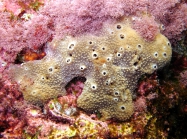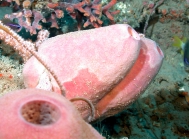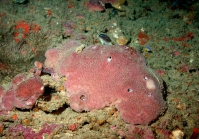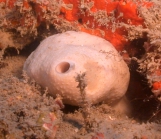
| About | | Search taxa | | Taxon tree | | Search literature | | Checklist | | Stats | | Log in |
WoRMS taxon detailsIrcinia Nardo, 1833
131751 (urn:lsid:marinespecies.org:taxname:131751)
accepted
Genus
Ircinia variabilis (Schmidt, 1862) (type by subsequent designation)
Dysidicinia Lendenfeld, 1889 · unaccepted (junior synonym)
Euricinia Lendenfeld, 1889 · unaccepted (junior synonym)
Filifera Lieberkühn, 1859 · unaccepted (junior synonym)
Filifera (Hircinia) Schmidt, 1862 · unaccepted (genus transfer)
Hircinella Lendenfeld, 1889 · unaccepted (junior synonym)
Hircinia Nardo, 1834 · unaccepted (unjustified emendation)
Hircinia (Dysidicinia) Lendenfeld, 1889 · unaccepted (junior synonym)
Hircinia (Euricinia) Lendenfeld, 1889 · unaccepted (junior synonym)
Hircinia (Hircinella) Lendenfeld, 1889 · unaccepted (junior synonym)
Hyrcinia Nardo, 1847 · unaccepted (misspelling of Hircinia)
Polytherses Duchassaing & Michelotti, 1864 · unaccepted (junior synonym)
Stematumenia Bowerbank, 1845 · unaccepted (junior synonym)
marine,
recent only
feminine
Nardo, G.D. (1833). Auszug aus einem neuen System der Spongiarien,wonach bereits die Aufstellung in der Universitäts-Sammlung zu Padua gemacht ist. Pp. 519-523. <em>In: Isis, oder Encyclopädische Zeitung Coll. (Oken: Jena).</em> [details]
Taxonomy All Nardo's 1833 Ircinia names are nomina nuda. Pronzato et al. (2004) proposed to indicate Ircinia spongiastrum as type...
Taxonomy All Nardo's 1833 Ircinia names are nomina nuda. Pronzato et al. (2004) proposed to indicate Ircinia spongiastrum as type species. This is very likely a growth form of the common Adriatic species Ircinia variabilis (Schmidt, 1862). This type species designation counteracts earlier attempts at type species designation by a.o. De Laubenfels (1948) and Cook & Bergquist (2002) which involved species not originally included in Ircinia when Nardo erected the genus. [details]
de Voogd, N.J.; Alvarez, B.; Boury-Esnault, N.; Cárdenas, P.; Díaz, M.-C.; Dohrmann, M.; Downey, R.; Goodwin, C.; Hajdu, E.; Hooper, J.N.A.; Kelly, M.; Klautau, M.; Lim, S.C.; Manconi, R.; Morrow, C.; Pinheiro, U.; Pisera, A.B.; Ríos, P.; Rützler, K.; Schönberg, C.; Turner, T.; Vacelet, J.; van Soest, R.W.M.; Xavier, J. (2025). World Porifera Database. Ircinia Nardo, 1833. Accessed through: World Register of Marine Species at: https://www.marinespecies.org/aphia.php?p=taxdetails&id=131751 on 2025-07-17
Date action by
Nomenclatureoriginal description
Nardo, G.D. (1833). Auszug aus einem neuen System der Spongiarien,wonach bereits die Aufstellung in der Universitäts-Sammlung zu Padua gemacht ist. Pp. 519-523. <em>In: Isis, oder Encyclopädische Zeitung Coll. (Oken: Jena).</em> [details] original description (of Hircinia Nardo, 1834) Nardo, G. D. (1834). De Spongiis. <em>Isis (Oken).</em> 714-716. [details] original description (of Hircinia (Euricinia) Lendenfeld, 1889) Lendenfeld, R. Von. (1889). Die Verwandtschaftsverhältnisse der Hornschwämme. Zoologische Jahrbücher. <em>Abteilung für Systematik,Geographie und Biologie der Thiere.</em> 4(1): 1-93. [details] original description (of Polytherses Duchassaing & Michelotti, 1864) Duchassaing de Fonbressin, P.; Michelotti, G. (1864). Spongiaires de la mer Caraibe. <em>Natuurkundige verhandelingen van de Hollandsche maatschappij der wetenschappen te Haarlem.</em> 21(2): 1-124, pls I-XXV. page(s): 67-68 [details] original description (of Stematumenia Bowerbank, 1845) Bowerbank, J.S. (1845). Observations on the Spongiadae, with descriptions of some new genera. <em>Annals and Magazine of Natural History.</em> 16(107): 400-410, pls XIII-XIV. page(s): 406-408 [details] original description (of Filifera Lieberkühn, 1859) Lieberkühn, N. (1859). Neue Beiträge zur Anatomie der Spongien. <em>Archiv für Anatomie und Physiologie.</em> 30(3): 353-382, 515-529, pls IX-XI. page(s): 353 [details] original description (of Dysidicinia Lendenfeld, 1889) Lendenfeld, R. von. (1889). A Monograph of the Horny Sponges. (Trübner and Co.: London). iii-iv, 1-936, pls 1-50., available online at https://babel.hathitrust.org/cgi/pt?id=chi.20735531;view=1up;seq=1 [details] original description (of Euricinia Lendenfeld, 1889) Lendenfeld, R. von. (1889). A Monograph of the Horny Sponges. (Trübner and Co.: London). iii-iv, 1-936, pls 1-50., available online at https://babel.hathitrust.org/cgi/pt?id=chi.20735531;view=1up;seq=1 [details] original description (of Euricinia Lendenfeld, 1889) Lendenfeld, R. Von. (1889). Die Verwandtschaftsverhältnisse der Hornschwämme. Zoologische Jahrbücher. <em>Abteilung für Systematik,Geographie und Biologie der Thiere.</em> 4(1): 1-93. [details] original description (of Hircinia (Hircinella) Lendenfeld, 1889) Lendenfeld, R. von. (1889). A Monograph of the Horny Sponges. (Trübner and Co.: London). iii-iv, 1-936, pls 1-50., available online at https://babel.hathitrust.org/cgi/pt?id=chi.20735531;view=1up;seq=1 page(s): 564 [details] original description (of Hircinia (Dysidicinia) Lendenfeld, 1889) Lendenfeld, R. von. (1889). A Monograph of the Horny Sponges. (Trübner and Co.: London). iii-iv, 1-936, pls 1-50., available online at https://babel.hathitrust.org/cgi/pt?id=chi.20735531;view=1up;seq=1 page(s): 565 [details] original description (of Filifera (Hircinia) Schmidt, 1862) Schmidt, O. (1862). Die Spongien des adriatischen Meeres. (Wilhelm Engelmann: Leipzig): i-viii, 1-88, pls 1-7. page(s): 32 [details] original description (of Hyrcinia Nardo, 1847) Nardo, G.D. (1847). Prospetto della fauna marina volgare del Veneto estuario con cenni sulle principali specie commestibili dell'Adriatico, sulle venete pesche, sulle valli, ecc. Pp. 113-156 (1-45 in reprint). <em>In: Venezia e le sue Lagune. Volume Secundo. G. Antonelli: Venezia.</em> [According to Carlo Froglia, the Prospetto and the Sinonimia were published simultaneously; the Sinonimia is here considered to have priority.]., available online at https://www.biodiversitylibrary.org/page/53300268 page(s): 115; note: Misspelling of genus name Hircinia [details] original description (of Hircinella Lendenfeld, 1889) Lendenfeld, R. von. (1889). A Monograph of the Horny Sponges. (Trübner and Co.: London). iii-iv, 1-936, pls 1-50., available online at https://babel.hathitrust.org/cgi/pt?id=chi.20735531;view=1up;seq=1 [details] basis of record Cook, S. de C.; Bergquist, P.R. (2002 [2004]). Family Irciniidae Gray, 1867. Pp. 1022-1027. <i>In</i>: Hooper, J.N.A. & Van Soest, R.W.M. (eds) <i>Systema Porifera - A guide to the classification of sponges</i>. (2 volumes) Kluwer Academic/ Plenum Publishers: New York, 1708 + xvliii. ISBN 978-1-4615-0747-5 (eBook electronic version). [details] Available for editors basis of record Cook, S. de C.; Bergquist, P.R. (2002). Family Irciniidae Gray, 1867. Pp. 1022-1027. <i>In</i>: Hooper, J.N.A. & Van Soest, R.W.M. (eds) <i>Systema Porifera - A guide to the classification of sponges</i>. (2 volumes) Kluwer Academic/ Plenum Publishers: New York, 1708 + xvliii. ISBN 0-306-47260-0 (printed version). [details] Available for editors Otheradditional source
Pronzato, R.; Malva, R.; Manconi, R. (2004). The taxonomic status of <i>Ircinia fasciculata</i>, <i>Ircinia felix</i>, and <i>Ircinia variabilis</i> (Dictyoceratida, Irciinidae). <i>In</i>: Pansini M, Pronzato R, Bavestrello G, Manconi R, Sarà M (eds) Sponge Science in the New Millenium. Papers contributed to the VI International Sponge Conference Rapallo (Italy) 29 September – 5 October 2002. <em>Bollettino dei Musei e degli Istituti Biologici della Univertità di Genova.</em> 68: 553-563. [details] Available for editors
additional source Fol, H. (1890). On the Anatomy of Horny Sponges belonging to the Genus <i>Hircinia</i>, and on a new Genus. <i>The Annals and Magazine of natural History, 6: 172-174</i>. page(s): 172 [details] additional source Garrone, R.; Vacelet, J.; Pavans de Ceccatty, M; Junqua, S.; Robert , L..; Huc, A. (1973). Une formation de collagène particulière: les filaments des éponges cornées <i>Ircinia</i>. Etude ultrastructurale, physico-chimique & biochimique. <i>Journal de Microscopie</i>. 17: 241-260. [details] Available for editors additional source Vacelet, J. (1959). Répartition générale des éponges et systématique des éponges cornées de la région de Marseille et de quelques stations méditerranéennes. <em>Recueil des Travaux de la Station marine d'Endoume.</em> 16 (26): 39-101, pls 1-3. page(s): 89 [details] Available for editors additional source Van Soest, R.W.M. (2001). Porifera, <b><i>in</i></b>: Costello, M.J. <i>et al.</i> (Ed.) (2001). <i>European register of marine species: a check-list of the marine species in Europe and a bibliography of guides to their identification</i>. <em>Collection Patrimoines Naturels.</em> 50: 85-103. (look up in IMIS) [details] additional source Bergquist, P.R. (1980). A revision of the supraspecific classification of the orders Dictyoceratida, Dendroceratida and Verongida (class Demospongiae). <em>New Zealand Journal of Zoology.</em> 7 (4): 443-503. page(s): 464-466 [details] Available for editors additional source Laubenfels, M.W. de. (1948). The order Keratosa of the phylum Porifera. A monographic study. <em>Occasional Papers of the Allan Hancock Foundation.</em> 3: 1-217. page(s): 65-66 [details] Available for editors  Present Present  Inaccurate Inaccurate  Introduced: alien Introduced: alien  Containing type locality Containing type locality
From editor or global species database
Taxonomy All Nardo's 1833 Ircinia names are nomina nuda. Pronzato et al. (2004) proposed to indicate Ircinia spongiastrum as type species. This is very likely a growth form of the common Adriatic species Ircinia variabilis (Schmidt, 1862). This type species designation counteracts earlier attempts at type species designation by a.o. De Laubenfels (1948) and Cook & Bergquist (2002) which involved species not originally included in Ircinia when Nardo erected the genus. [details]Unreviewed
Habitat Known from seamounts and knolls [details]
To European Nucleotide Archive, ENA (Filifera) (from synonym Filifera Lieberkühn, 1859)
To European Nucleotide Archive, ENA (Ircinia) To Genbank To Sponge Barcoding Database (Ircinia sp. 1244) To Sponge Barcoding Database (Ircinia sp. 1244) To Sponge Barcoding Database (Ircinia sp. 1244) To Sponge Barcoding Database (Ircinia sp. 2828) To Sponge Barcoding Database (Ircinia sp. 3173) To Sponge Barcoding Database (Ircinia sp. 3173) To Sponge Barcoding Database (Ircinia sp. 3304) To Sponge Barcoding Database (Ircinia sp. 3304) To Sponge Barcoding Database (Ircinia sp. 3313) To Sponge Barcoding Database (Ircinia sp. 3313) To Sponge Barcoding Database (Ircinia sp. 3325) To Sponge Barcoding Database (Ircinia sp. 3353) To Sponge Barcoding Database (Ircinia sp. 3810) To Sponge Barcoding Database (Ircinia sp. 3810) To Yale Peabody Museum of Natural History (YPM IZ 005551.PR) To ITIS |





